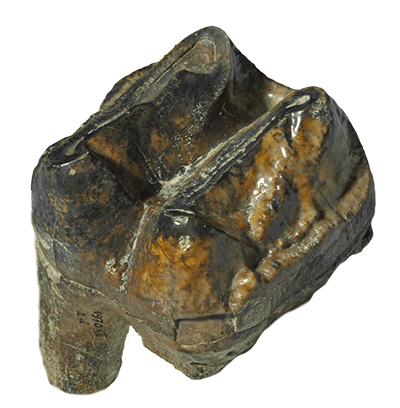August 2024: Deinotherium
Hoe tusker
Deinotherium giganteum Kaup, 1829
Upper molar
Neogene: Middle/Upper Miocene, approx. 11 million years old
Ebing (Waldkraiburg), district of Mühldorf (Upper Bavaria)
Length 85 mm, width 90 mm, height 120 mm

In 1968, hobby fisherman H. Kretschmann from Munich found the tusk tip of a huge hoe tusker of the species Deinotherium giganteum on the banks of the river Inn near the village of Ebing and donated it to the State Collection. In October 1970, in addition to the rest of the tusk, the Inn had uncovered large parts of a lower jaw branch, the second tusk and many molars from the lower and upper jaw. The fossil of the month comes from this series of finds.
Even if the name suggests it, hoe tuskers (scientific name Deinotheriidae) were no elephants. Like elephants (scientific name Elephantidae, consisting of the African elephant, forest elephant, Indian elephant, †woolly mammoth and other extinct genera), they were large and had columnar legs, a trunk and tusks. Like elephants, hoe tuskers or deinotheres belong to the large group of proboscideans (scientific name Proboscidea). However, they split off from the other proboscidean lineages very early on and developed quite independently. They had a body shape with a horizontal dorsal line, a relatively long neck and a comparatively flat skull. Their molars differed significantly from those of elephants and they only had a pair of tusks in the lower jaw, which were curved downwards and backwards. The hoe-like appearance of the Deinotherium tusks gave these animals their colloquial name.
The deinotheriids migrated from Africa to Eurasia in the Miocene, between 19.5 and 17.5 million years ago. As the climate cooled, they disappeared from Eurasia around 4-3 million years ago and finally became extinct in Africa around 1 million years ago. In the course of their evolution, their body size increased from less than 1 m shoulder height to over 4 m, making them larger than today’s largest land-living animal, the African elephant, and thus belonging to the group of the largest land-living animals that have ever existed on earth.
In Bavaria, the deinotheres have been recorded from around 17 to 11 million years ago with three successive species. They lived in the then subtropical deciduous forests of the foothills of the Alps and shared their habitat with at least two other species of proboscideans. The fossil of the month belongs to the species Deinotherium giganteum and is the most recent evidence of the hoe tuskers in Bavaria.
Gertrud E. Rössner



